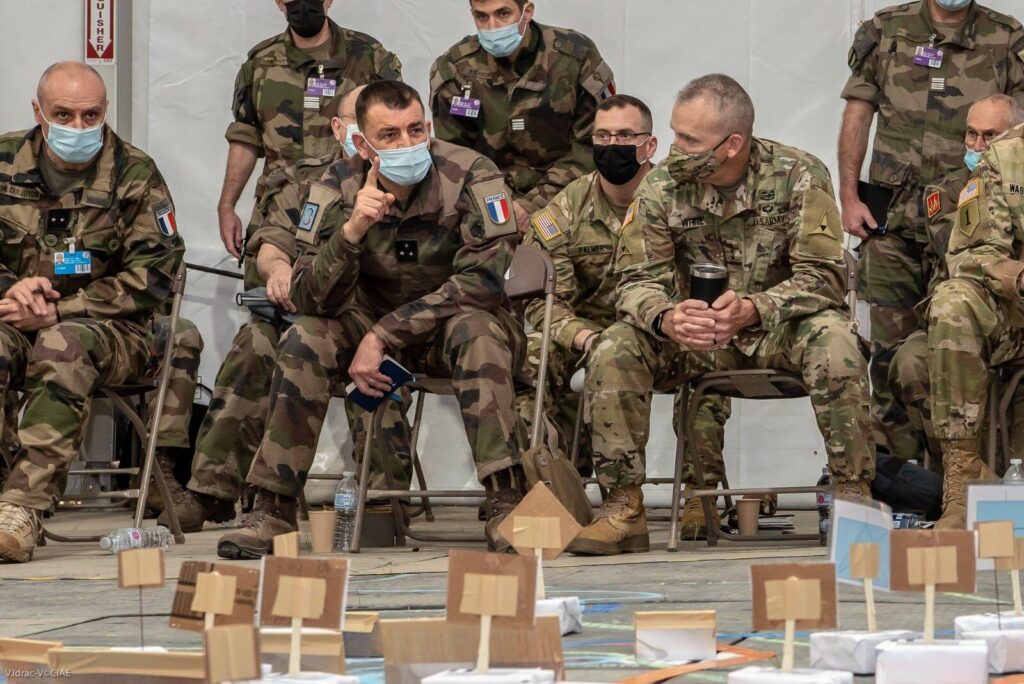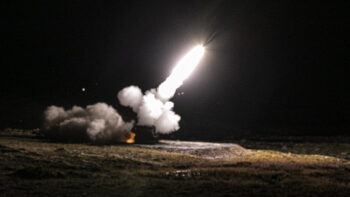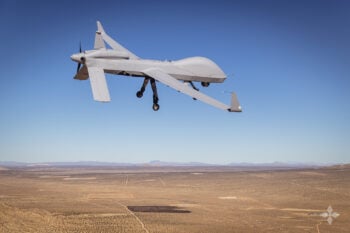
Maj. Gen. Laurent Michon, 3rd French Division commander, center left, and Lt. Gen. Pat White, Fort Hood commanding general, center right, survey the “battlefield” during Warfighter 21-4.
The U.S. Army’s III Corps trained for almost 10 days alongside the British 3rd Division and France’s 3rd Division in a rare senior allied command exercise in April. Fort Hood-based III Corps was tasked to incorporate divisional headquarters from the US, the UK and France.
The US invited two of its closest allies during a pandemic, requiring extremely thorough preparation and organization. Some 1,350 British Army troops and 1,000 from the French Army came to American soil. A total of 3,000 troops (about half players and half in support) participated across four bases, creating an AOR (Area of Responsibility) the size of Europe. The bases included Fort Hood and Fort Bliss in Texas; Fort Bragg in North Carolina and Grafenwoehr in Germany.
 The exercise, Warfighter 21-4 (WFX 21-4), is an annual US Army command exercise designed to test tactical command at the Corps level in a high-intensity warfighting scenario. It was held between April 6 and April 15.
The exercise, Warfighter 21-4 (WFX 21-4), is an annual US Army command exercise designed to test tactical command at the Corps level in a high-intensity warfighting scenario. It was held between April 6 and April 15.
It was the first time that a UK division and a French division operated alongside a US armored division under command of the US III Corps. It was also the first time such integration was attempted in subordinate formations: the 1st AD commanded three US brigades and one British brigade; the 3rd UK Division commanded three British brigades and one US brigade; and finally, the 3rd French Division commanded two French brigades (2e BB and 11e BP) and one US brigade (2/4 ID).
Agility is what Col Rémi Bouzereau, the French Military Attache in Washington, emphasized as a lesson learned, pointing out that the 3rd French Division had just returned from a deployment in Sahel and shifted quickly from COIN to high intensity warfare.
Both agreed there is room for further development in areas such as electronic warfare and signals intelligence. “These ‘soft’ components were not as accessible in the past 12 to 15 years when we were so busy in the Middle-East; for example, there is a real drive to invest in areas such as EWSI (Electronic Warfare and Signals Intelligence),” Brig. Gen. Paul Tennant, the British military attache in Washington. Such a finding was one among the many lessons learned of this exercise.
The full spectrum of capabilities were deployed and tested.
“Our detachment reflected a full divisional order of battle which consisted of a Divisional Reconnaissance Battlegroup and a total of 4 brigades (one of which was US) with 1 Division Artillery Group, 1 Air Manoeuvre Battlegroup, 1 Combat Aviation Brigade, 1 Signals Brigade, 1 Logistic Brigade, 1 Information Manoeuvre Group, 1 Divisional Engineering Group and 1 Hospital Treatment Group. The presence of a divisional reconnaissance group and an information manoeuvre group were especially focused on the future, reflecting many of the capabilities for which the British Army is planning to restructure,” Tennant explained.
Ever since the first Gulf war, the three countries have worked hard to communicate, but the connection of networks is highly complex. The success of Warfighter 21-4 owes much to the contributions of the respective signals staff and the US Army Digital Liaison Detachment – without whom communications would have been even more challenging.
Aloha: Fixes ongoing, then Army’s new watercraft prototype is Hawaii bound for testing
“Everything that we can knock off that list we will do in the archipelago…because that allows us to do the tests in the environment that the vessel will operate in ultimately,” said Maj. Gen. Jered Helwig.


























